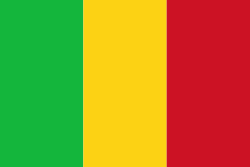Sikasso
Sikasso (Bambara: ߛߌߞߊߛߏ tr. Sikaso) is a city in the south of Mali and the capital of the Sikasso Cercle and the Sikasso Region. It is Mali's second largest city with 225,753 residents in the 2009 census.
Sikasso was founded at the beginning of the nineteenth century by Mansa Douala. The town was a small village until 1876 when Tieba Traoré, whose mother came from Sikasso, became King of the Kénédougou Empire and moved its capital there. He established his palace on the sacred Mamelon hill (now home to a water tower) and constructed a tata or fortifying wall to defend against the attacks of both the Malinke conqueror Samori Ture and the French colonial army. The city withstood a long siege from 1887 to 1888 but fell to the French in 1898. Rather than surrender to the colonial army, Tieba's brother Babemba Traoré, who had succeeded him as king, committed suicide, honoring the famous Bamanankan saying "Saya ka fisa ni maloya ye" (literally: death is preferable to shame).
Attractions today include the large market, Mamelon hill, the remains of Tieba Traoré's tata, and the nearby Missirikoro Grotto. The festival Triangle du balafon takes place every June, celebrating the traditional Malian instrument.
Sikasso's sister city is Brive-la-Gaillarde, France.
Sikasso was founded at the beginning of the nineteenth century by Mansa Douala. The town was a small village until 1876 when Tieba Traoré, whose mother came from Sikasso, became King of the Kénédougou Empire and moved its capital there. He established his palace on the sacred Mamelon hill (now home to a water tower) and constructed a tata or fortifying wall to defend against the attacks of both the Malinke conqueror Samori Ture and the French colonial army. The city withstood a long siege from 1887 to 1888 but fell to the French in 1898. Rather than surrender to the colonial army, Tieba's brother Babemba Traoré, who had succeeded him as king, committed suicide, honoring the famous Bamanankan saying "Saya ka fisa ni maloya ye" (literally: death is preferable to shame).
Attractions today include the large market, Mamelon hill, the remains of Tieba Traoré's tata, and the nearby Missirikoro Grotto. The festival Triangle du balafon takes place every June, celebrating the traditional Malian instrument.
Sikasso's sister city is Brive-la-Gaillarde, France.
Map - Sikasso
Map
Country - Mali
 |
|
| Flag of Mali | |
Present-day Mali was once part of three extremely powerful and wealthy West African empires that controlled trans-Saharan trade: the Ghana Empire (for which Ghana is named), the Mali Empire (for which Mali is named), and the Songhai Empire. At its peak in 1300, the Mali Empire was the wealthiest country in Africa, covering an area about twice the size of modern-day France and stretched to the west coast of the continent. Mali was also one of the wealthiest countries on earth, and its emperor at its zenith, Mansa Musa, is believed to be possibly the wealthiest individual in history. Besides being an economic powerhouse, medieval Mali was a centre of Islam, culture and knowledge, with Timbuktu becoming a renowned place of learning with its university, one of the oldest in the world still active. The expanding Songhai Empire absorbed the empire in 1468, followed by a Saadian army which defeated the Songhai in 1591. In the late 19th century, during the Scramble for Africa, France seized control of Mali, making it a part of French Sudan. French Sudan (then known as the Sudanese Republic) joined with Senegal in 1959, achieving independence in 1960 as the Mali Federation. Shortly thereafter, following Senegal's withdrawal from the federation, the Sudanese Republic declared itself the independent Republic of Mali. After a long period of one-party rule, a coup in 1991 led to the writing of a new constitution and the establishment of Mali as a democratic, multi-party state.
Currency / Language
| ISO | Currency | Symbol | Significant figures |
|---|---|---|---|
| XOF | West African CFA franc | Fr | 0 |
| ISO | Language |
|---|---|
| BM | Bambara language |
| FR | French language |















